Fertilizers will darken the leaves over time and help stimulate good Plum fruit production. Different soils may have different amounts of local elements needed to support the growth and development of Plum trees. If you find out that your soil is deficient in any essential nutrients (nitrogen, phosphorate, potash, etc.), choose a fertilizer that makes up for soil nutrient deficiency. Let’s check out the best fertilizer for Plum trees.
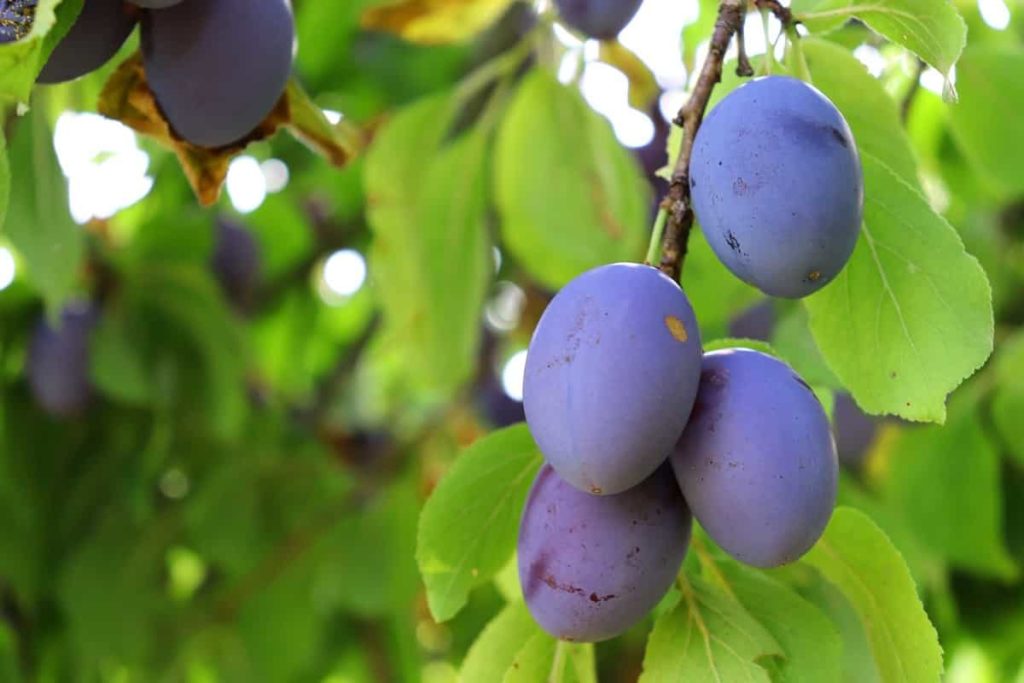
Plum trees planted in very fertile soil may not need fertilization until they use many nutrients. If growth stops and you don’t see at least 1 foot of growth every year, or what should be dark green leaves have turned light green, it indicates the need for fertilization. If the leaves are light green, the tree cannot effectively photosynthesize for the best fruit production. Plum trees thrive when macronutrients such as nitrogen, phosphorus, and potassium are present in the soil. Nitrogen helps in encouraging vegetative growth (leaves and branches).
Nitrogen is an essential factor for the fundamental development of Plum trees and most other fruit trees, dramatic reactions if there is too much nitrogen. Nitrogen redirects energy from fruit production to leaves and shoots. If the soil contains too much nitrogen, the fruits can fall to the ground prematurely before they are fully ready. Phosphorus encourages the growth of Plum roots and flowers.
Potassium/Potash is responsible for the resistance to the natural disease of the Plum and the usefulness of systems supporting its overall health, like an immune system. In addition, a water-soluble fertilizer specifically prepared for young Plum trees provides these trees with nutrients they take during their early years in the ground when they are set up.
Best fertilizer for Plum Trees
Homemade fertilizers for Plum
Epsom salt
Fruit trees such as citrus and Plum grow best after applying Epsom salt. For fruit trees, Epsom salt supports the production of fruits and absorption of essential nutrients that increase sweetness. A low crop or fruit which is not sweet can also indicate the need for more magnesium.
Coffee grounds
Coffee grounds contain nutrients, including nitrogen, phosphorus, magnesium, and copper. These readily available nutrients are essential for the health of Plum trees. Unfortunately, coffee grounds also increase the acidity of the ground.
In case you miss this: Plum Gardening For Beginners, How to Start

Eggshells
Powdered or crushed egg peels are best placed around Plum trees and pot plants, although they will be beneficial anywhere in the garden.
Wood ash
Most fruit trees can benefit from a bit of sprinkling of wood ash. These include fruits like Sweet Apples, Pears, Plums.
Compost manure for Plum
Compost
Fertilizers can burn the roots of Plum while planting. Improve soil fertility without this adverse effect by modifying soil with compost. When you have dug holes for a Plum root ball, mix local soil with compost in proportion to about 3 or 4 parts of soil to 1 part of the compost. Once the tree’s root ball is in the ground, fill the space around the root ball with modified local soil. Compost has the added advantage of improving soil drainage and moisture retention.
Manure
The best fertilizer for Plum trees is chicken or rabbit manure because they have more NPK than other fertilizers like cows, horses, and goats. Manure is one of the best fertilizers for fruit trees as it has a high NPK with other trace nutrients. In addition, manure contains organic carbon compared to chemical fertilizers, which dramatically improve soil health. Once composted, apply manure around the Plum tree drip line.
Worm castings
You can make compost tea from worm castings. Worm castings are not only rich in nutrients but also filled with beneficial microorganisms. Before brewing, you can make compost tea only from worm castings or add castings to plant-based compost.
In case you miss this: Plumeria Gardening For Beginners, How To Start
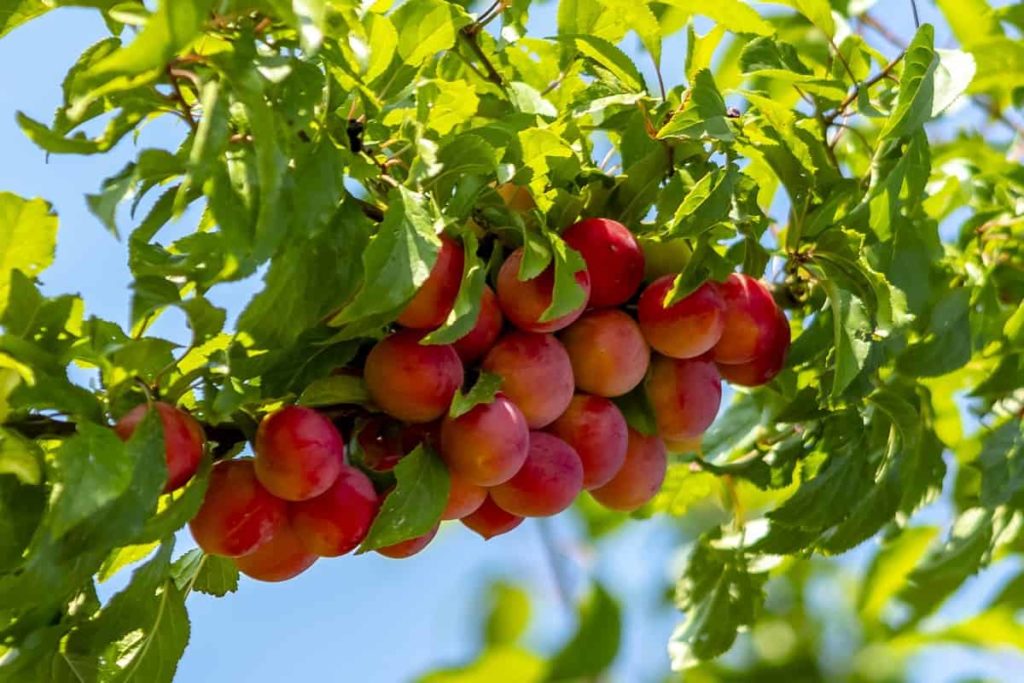
Organic fertilizers for Plum
Bone meal
Bone meal provides phosphorus to Plum trees. As one of the three main macronutrients for plants, phosphorus promotes early growth, root formation, and fruit growth.
Blood meal
It provides a high nitrogen level, which can hinder fruits and flowers. The blood and bone are the organic products that will not burn your plants as nutrients release slowly.
Soybean meal
Soybean meal organic fertilizer is a rich source of nitrogen and phosphorus. It is very close in composition to an alfalfa meal.
Natural fertilizers for Plum
Mulch is a coat of organic material usually made of leaf debris, bark, or manure. The initiative will help in enriching soil salinity, preventing weed growth, maintaining water during dry months, and providing warmth in the winter. You should apply mulch in the first four years of your new Plum and do its best in the middle of spring. Then, to help protect your tree from winter, use another tree of mulch in the fall. It is essential to provide adequate nutrients to promote healthy fruit production while taking care of Plum trees.
Liquid fertilizers for Plum
Compost tea
The easiest way to make compost tea is to shovel a scoop of compost into a bucket, cover it with water, and let it stand for a few days. Then, you can pour tea under the tree to feed the roots or use a sprayer to spray it on leaves.
Fish emulsion
All kinds of organic fertilizer have their nutritional value, which you should consider before applying it to the fruit tree. Fish emulsion is high in nitrogen, and fruit trees can burn if used excessively.
In case you miss this: How to Start a Fruit Garden from Scratch
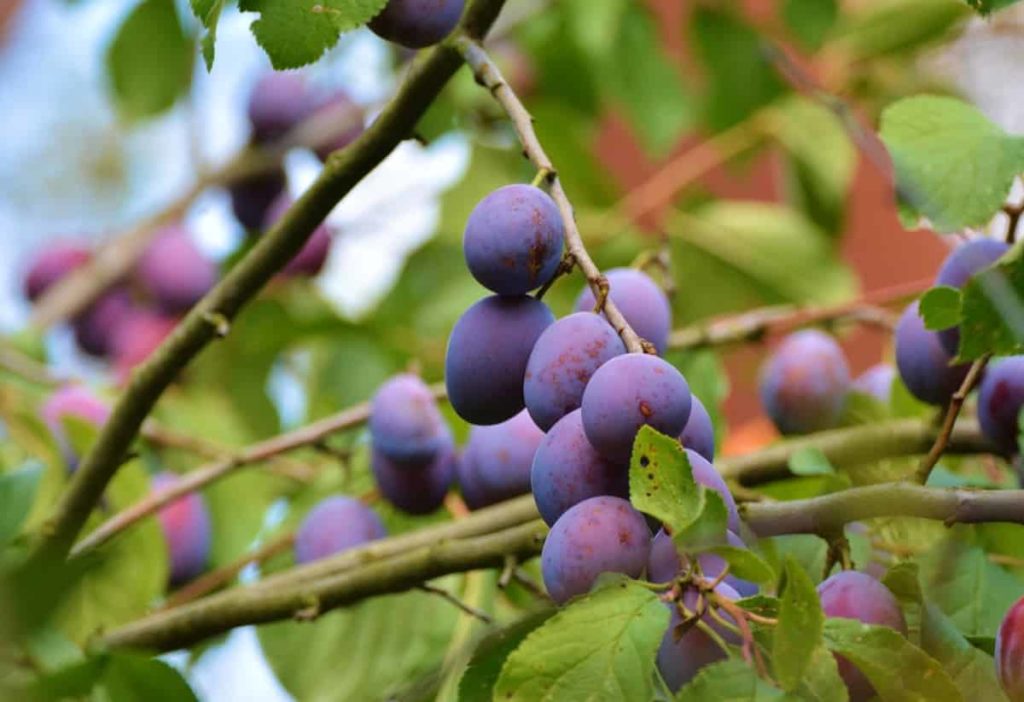
Commercial fertilizers for Plum
NPK ratio
10-10-10 fertilizer is an all-purpose fertilizer that meets the needs of Plum trees during the growing season. Lack of iron, zinc, or calcium in the ground can affect healthy Plum growth. Iron-deficient Plums produce yellow or yellow-green leaves with dark green veins and can appear brown on the edges of the leaves. Mix 2 cups of chelated iron with 1 gallon of water in a Sprayer, and coat the Plum tree leaves ultimately with spray at intervals of two weeks during the flower season.
Zinc-deficient leaves are smaller than more mature leaves, with smaller leaves yellowing with significant green veins. Mix one tablespoon zinc sulfate with 1 gallon of water and soak the leaves and stem completely. Calcium deficiency is less common in Plums, but symptoms include brown fruit wounds and dead spots at the center of leaves. Dissolve 18 grams of calcium chloride in 1 gallon of water, and spray the leaves evenly.
Plum fertilizer schedule
- Do not apply fertilizer when planting a Plum tree during the dormant season, when there are no leaves of trees. Wait for fertilizer to be added until new growth emerges in spring.
- Soil testing, the amount of growth of the previous year, and the age of the tree will give a good idea of the fertilizer requirements for Plums.
- For newly planted Plum fertilize a cup 10-10-10 fertilizer by broadcasting it in an area that is around three feet. In the middle of May and the middle of July, apply a 1/2 cup calcium nitrate or ammonium nitrate over an area of about two feet in diameter. This feeding will provide additional nitrogen to the tree.
- In the second year and later in early March, the tree will be fertilized twice a year and then for the first time in August. For the March application, apply 1 cup of 10-10-10 for each year of the tree for 12 years.
In case you miss this: Top 25 Fast Growing Vegetables in Pots
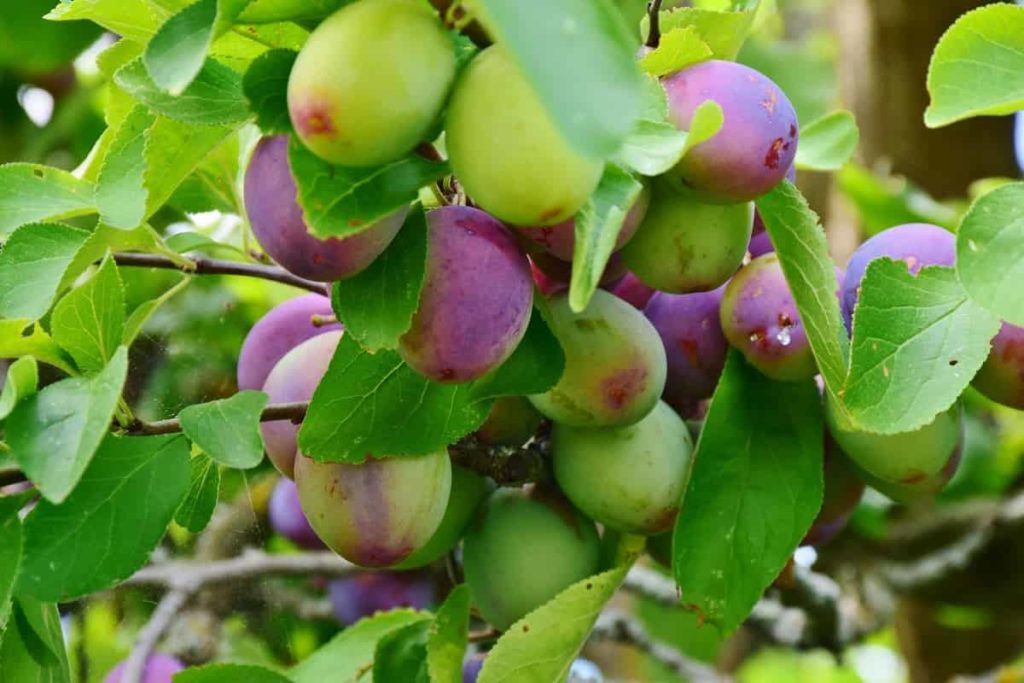
- If the Plum tree is 12 years or older, apply only 1/2 cup of fertilizer to the mature tree. Apply up to 6 cups of calcium nitrate or ammonium nitrate per tree for mature trees in August. Broadcast any fertilizer in a wide range, at least like a circle produced from tree limbs. Be careful to keep the manure away from the tree trunk.
- Granular manure that you sprinkle on the ground is suitable for regular annual feeding. Watering immediately after the application dissolves granular fertilizers, allowing nutrients to soak in the soil where roots can access them.
- Keep an eye on signs of overfertilization during the growing season. Your Plum trees should grow about 12 to 18 inches every year. Reduce the amount of fertilizer you consume in the coming year if your trees are characterized by excessive growth or leaf burns. Water the site deeply after each fertilizer application.
How to fertilize Plum in pot
Plum trees grown in containers can be fertilized when planted during spring and summer but avoid fertilization two months before the normal first frost date in your area. Late fertilization can trigger new tender growth that can damage, and an initial freeze can damage the entire tree. Plum trees grow best fertilized once per year, before fruit growth begins in early spring, with an all-purpose fertilizer or aged manure. Avoid fertilizing your Plum tree after the fruit starts. Any new growth will turn energy away from fruit production.
In case you miss this: Top 15 Fruits to Grow in Pots
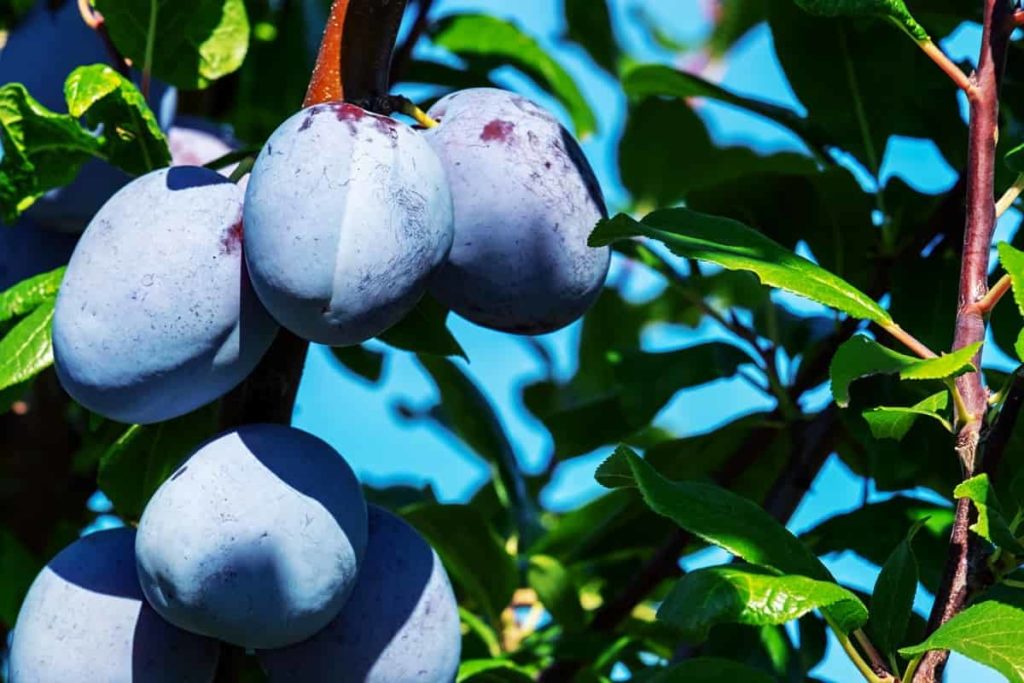
Frequently asked questions about fertilizers for Plum
Why is my Plum tree dropping fruit?
There can be numerous reasons why a Plum tree drops its fruit before ripening: insects, disease, strong winds, and stress (too much water, too little water, nutrient deficiency, poor drainage, weed competition, and excessive shade).
Why is my Plum tree losing leaves in the summer?
Deficiencies of nutrients such as boron, iron, manganese, sulfur, or nitrogen can help the Plum tree leaves fall off.
Why are my Plum tree leaves wilting?
Check the soil moisture and make sure the tree is getting proper water. Too much or not sufficient water can cause wilting. Even established trees suffer in the hot and drought summer.
- How to Grow Hibiscus from Flower
- Plantation Ideas for Home Decoration: A Beginners Guide
- Flower Garden Designs and Layouts for Beginners
- Planting and Spacing Techniques in Papaya: A Beginner’s Guide
- Growing Gold: Essential Techniques for Planting Pineapples
- How to Make Kalanchoe Plant Bushy: Home Remedies and Solutions
- 11 Reasons Why Your Gardenia is Not Blooming: Home Remedies and Solutions
- Eco Elegance: The Guide to Designing a Drought-Tolerant Landscape
- Gardening on a Slope: Strategies for Hillside Landscaping
- Nourish and Flourish: Top Organic Mulches for Thriving House Plants
- Everything You Want to Know about Indian Mogra Flower: Discover Uses and Growing
- Green Thumb Success: Expert Tips for Cultivating Greenhouse Pumpkins All Year Round
- Maximize Growth & Flavor: The Ultimate Guide to Companion Planting in Herb Gardens
- How to Control Rhododendron Problems Naturally: Home Remedies and Organic Ways to Fix Them
- Natural Magic: The Remarkable Benefits of Cinnamon for Plants
- Best Steps to Revive Dying Tulip with Natural and Organic Treatment
- 10 Reasons Why Your Angel Trumpet is Not Blooming: Remedies and Treatment
- How to Fix Periwinkle Leaf and Flower-Related Problems: Natural Remedies and Solutions
- How to Fix Zinnias Leaf and Flower Problems: Discover Natural and Home Remedies
- Organic Steps to Induce Lemon Tree Flowers: A Comprehensive Guide
- Bloom Booster: Crafting the Perfect Homemade Bougainvillea Fertilizer
- Optimizing Growth: A Guide to Applying NPK Fertilizer for Potted Plants
- 10 Best Homemade Fertilizers for Rubber Plant: DIY Recipes and Application Method
- How to Boost Female Pumpkin Flowers: Effective Steps for More Flowers and High Yields
- Transform Your Indoor Garden: Top Benefits of Pink Salt for Houseplants
- 10 Best Homemade Fertilizers for Peacock Plants (Calathea): Easy DIY Guide
- Unlock Blooms: 9 Reasons Why Your Potted Chrysanthemum is Not Blooming
- 8 Reasons Why Your Potted Hibiscus is Not Blooming: Fix it with Simple Solutions
- Unlock Blooms: 9 Key Reasons Your Potted Frangipani Won’t Flower
- 10 Reasons Why Is My Ice Plant Not Blooming: Remedies and Treatment
- 10 Reasons Why My Potted Hydrangea Not Blooming: Treatment and Remedies
- 10 Reasons Why is My Wisteria Not Blooming: Remedies and Treatment
- 10 Reasons Why is My Goldfish Plant Not Blooming: Remedies and Treatment
- Maximize Your Space: Ultimate Guide to Balcony Gardening with Grow Bags
- 10 Reasons Why Your Iris is Not Blooming: Remedies and Treatment
- 10 Reasons Why Your Anthurium Plant is Not Blooming: Treatment and Remedies